RABIT™ Bridge Deck Assessment Tool
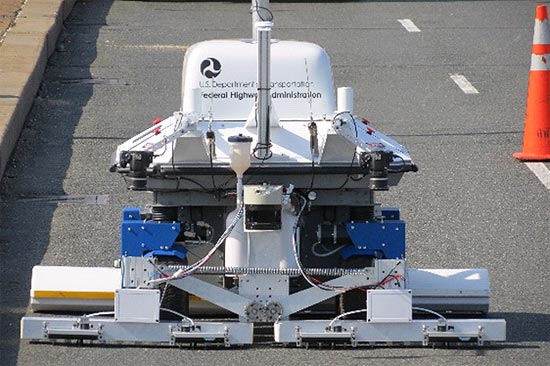
In the United States, the stewardship and management of approximately 600,000 bridges present ongoing planning, operational, maintenance, and economic challenges for Federal, State, and local transportation agencies. Bridge condition assessments help us plan and prioritize structure rehabilitation plans. Collecting data on the health of these bridges, however, can be a time-consuming, labor-intensive, and costly process.
The Federal Highway Administration Long-Term Bridge Performance (LTBP) program developed a multifunctional nondestructive evaluation (NDE) platform to enhance assessment of bridge decks. The RABIT™ bridge deck assessment tool was developed to deploy a suit of NDE technologies simultaneously. The technologies incorporated into the robot-assisted, remote controlled RABIT™ bridge deck assessment tool include:
- Panoramic Camera to collect high-quality, 360-degree images around the bridge deck.
- High-Definition Imaging to capture high-resolution images of the deck surface using professional-grade cameras.
- Electrical Resistivity to characterize the corrosive environment of the concrete.
- Impact Echo and Ultrasonic Surface Waves to evaluate concrete delamination and concrete deck strength.
- Ground Penetrating Radar (GPR) to “map” rebar and other metallic objects below the surface using electromagnetic waves. GPR also provides a qualitative assessment of concrete deck deterioration.
- Global Positioning System (GPS) to record and mark location data, making testing grids virtually obsolete.
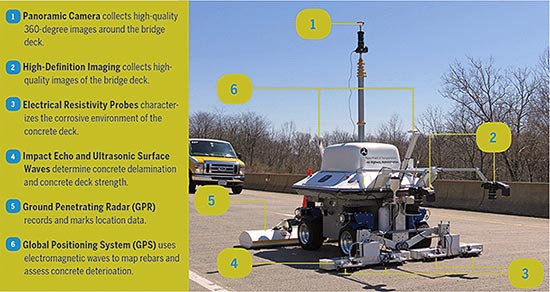
The RABIT™ bridge deck assessment tool collects comprehensive data on surface and subsurface conditions automatically and simultaneously.
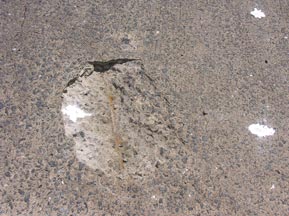
An example of bridge deck deterioration
What does the RABIT™ bridge deck assessment tool detect?
The unique combination of surface and subsurface condition assessment tools allows bridge managers and engineers to easily identify the anticipated future condition concerns of a bridge deck. All of the data collected by the RABIT™bridge deck assessment tool is tagged with exact GPS position coordinates for precise location reference.
Corrosion occurs when moisture and salt penetrate the concrete. As a result, rebar starts to corrode and concrete begins to crack and disintegrate. The RABIT™ bridge inspection tool features two NDE technologies that can identify corrosive environments: electrical resistivity and ground penetrating radar (GPR).
Concrete Quality Degradation is caused by many factors. Ultrasonic surface waves and GPR can detect changes in the quality of the concrete deck, while high-resolution imaging provides visual documentation of deck surface conditions.
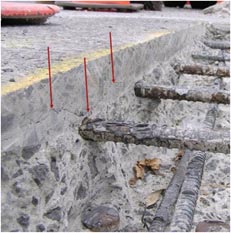
An example of bridge deck delamination
Delamination is the beginning of division and separation of layers of a concrete bridge deck, weakening the bridge deck and making it more susceptible to the environment and traffic loads. The RABIT™ bridge deck assessment tool’s impact echo system, ground penetrating radar, high-resolution imaging, and GPS capabilities precisely locate delaminated areas to enable bridge owners to make the right repair decisions.
How does the RABIT™ bridge inspection tool collect and analyze data?
RABIT™ collects a wide range of data simultaneously—high-resolution photographic, electromagnetic, seismic, and electrical—on external and internal bridge deck condition. The same van that transports the RABIT™ to various testing sites doubles as a mobile command center. The data collected by the RABIT™ is transmitted wirelessly to a computer in the van for processing and display. Inside the van, engineers and inspectors use four main displays: NDE data collection and imaging, data analysis, real-time deck condition data, and crack mapping. This allows engineers and inspectors to analyze and share photographic, seismic, and location data at once.
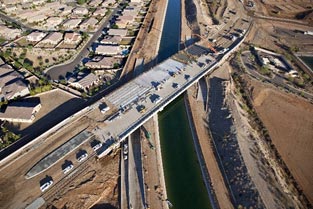
The RABIT™ bridge deck assessment tool helps policymakers create data-driven concrete bridge deck management plans to improve safety, mobility, and the economy.\
Is the RABIT™ bridge inspection tool safe for workers and vehicles?
The RABIT™ bridge deck assessment tool can use a high-accuracy GPS to examine a bridge deck on its own, eliminating the need for grid markings or traffic closures. Four omnidirectional wheels allow it to move smoothly at a zero radius, unlike traditional roadway vehicles. Finally, a laser scanning system protects the RABIT™ bridge deck assessment tool against collision with barriers, curbs, vehicles, and people.
What does this mean for the future of America's bridges?
Data gathered from the RABIT™ bridge deck assessment tool will improve understanding about the service life and performance of concrete decks on specific bridge types.
Quantitative information on concrete deck performance may lead to policies and procedures that help bridge managers make data-driven decisions and improve efficiency, speed, and cost-effectiveness of maintenance and rehabilitation measures.
Ultimately, improved understanding of concrete deck performance will promote the safety, mobility, longevity, and reliability of the Nation’s highway transportation assets.

